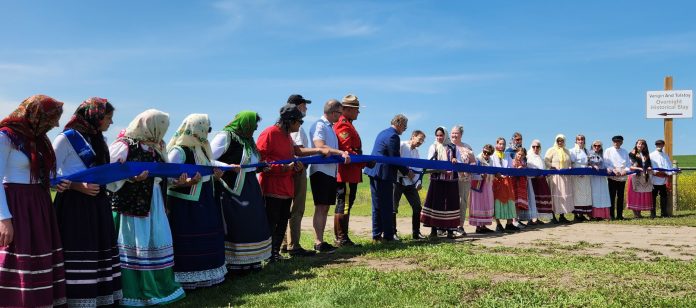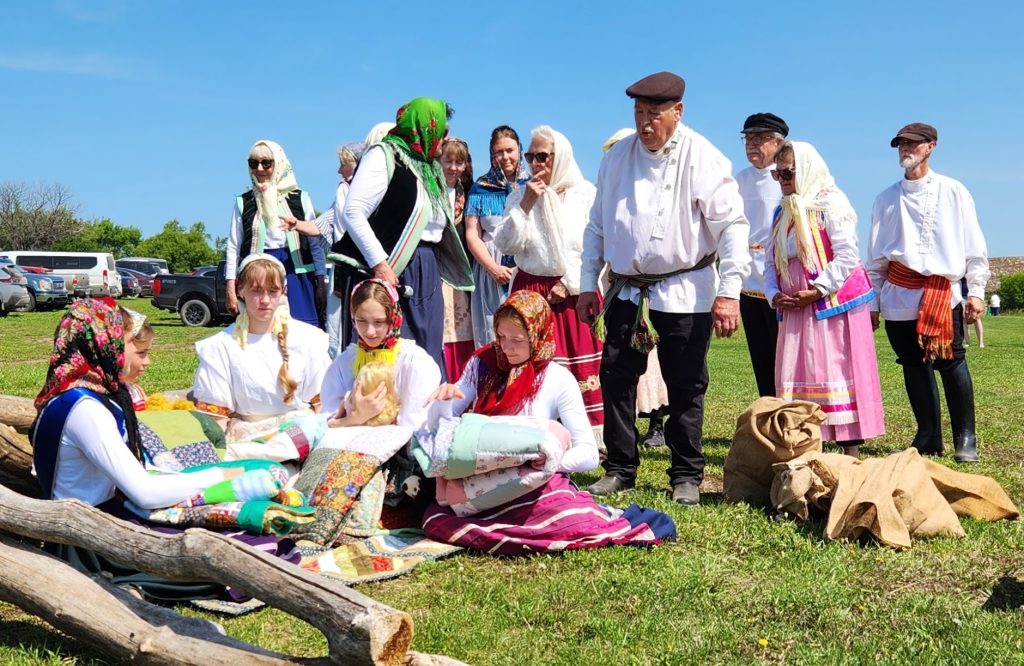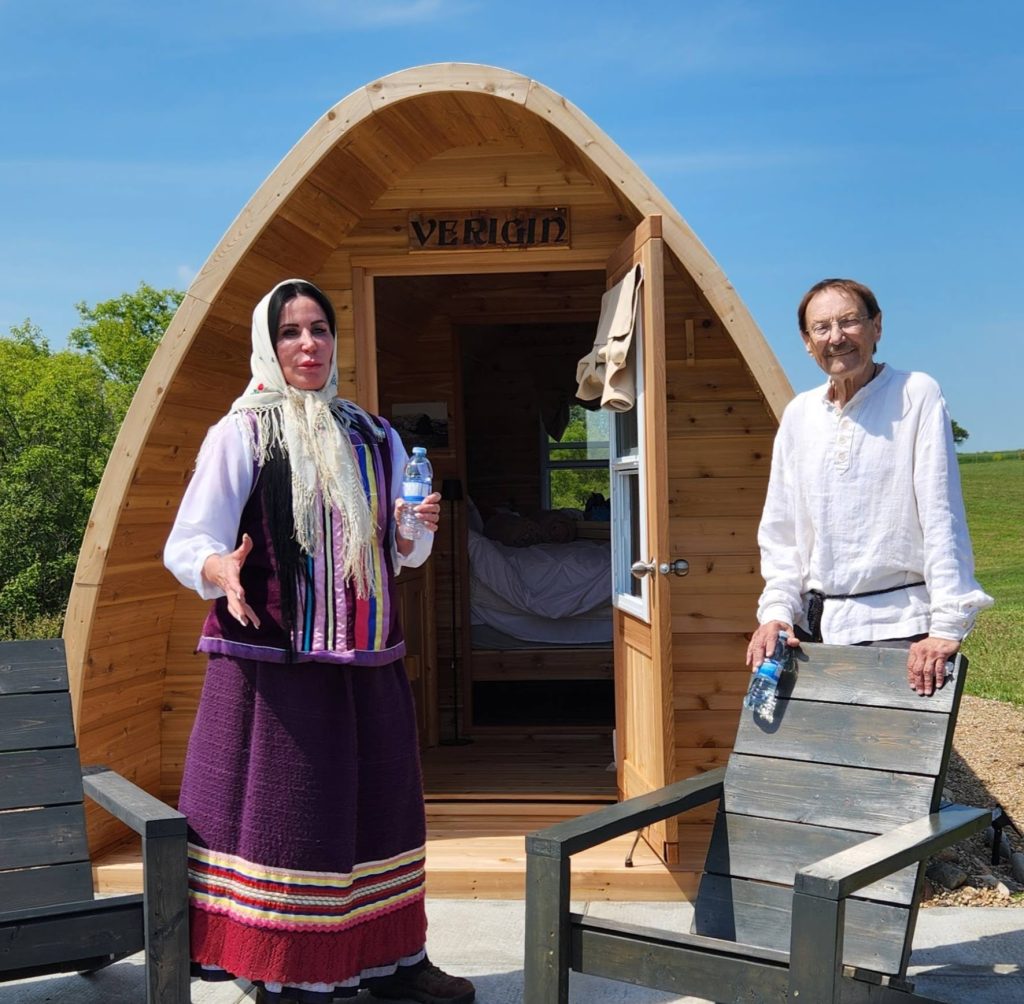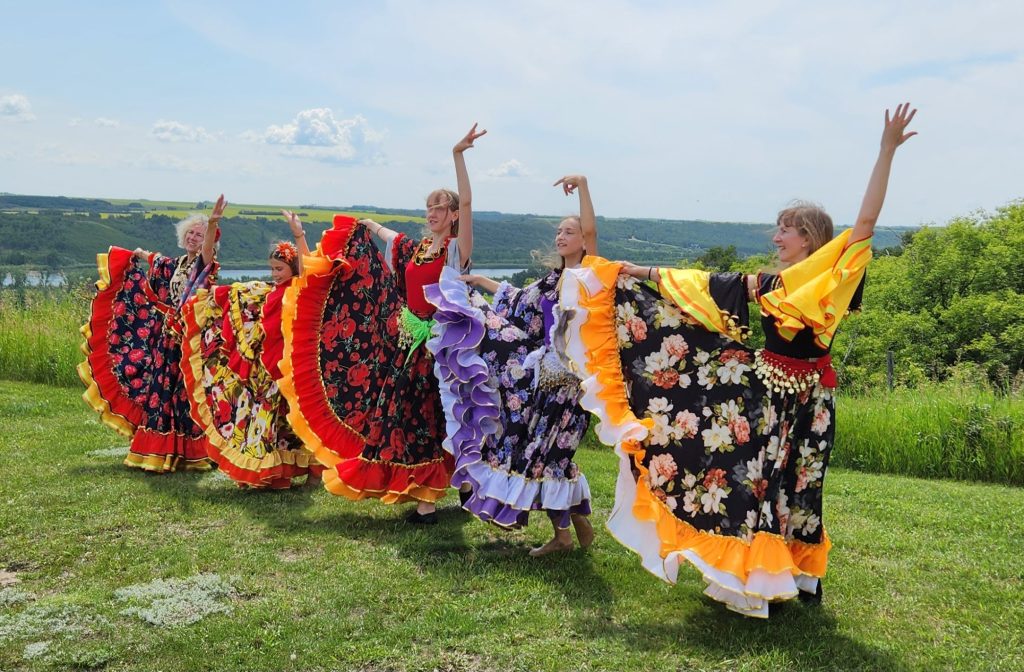
Glenda Goertzen
Special to the Herald
BLAINE LAKE – People with an interest in Saskatchewan’s Doukhobor community can now immerse themselves in their history with cultural overnight stays at the Doukhobor Dugout House.
On Saturday, July 6, the Doukhobor Dugout House held a ceremony to celebrate the opening of the Verigin and Tolstoy Overnight Historical Stay.
Founder Brenda Cheveldayoff expressed a hope that the events of the day would help visitors understand the importance of the Doukhobor heritage.
“The way the people lived; peace and harmony without that war thing going on that everybody talks about, which is something that we do not believe in. It’s why we were kicked out of Russia. We did not believe in fighting war.”
The origins of the Doukhobor Dugout House date back to the middle of the 17th century, when a peasant group split from the Russian Orthodox Church on moral and liturgical grounds. They believed that God did not dwell in the church, but in each human being. An Orthodox archbishop referred to them as Doukhobors, meaning “spirit wrestlers”. While he meant the term to be derogatory, the group embraced it.
Centuries later, many of their descendants still live by the slogan promoted by one of their leaders, “toil and peaceful life.” Most Doukhobors in Canada no longer live communally, but all practice pacifism and many are vegetarians.

The actors in Blankets of Comfort, wearing traditional garments handed down from ancestors in Russia, re-enacted the experience of building the first dugout shelter in 1899. — Photo by Glenda Goertzen
As part of the day’s events to celebrate the opening of the new overnight area, members of the Doukhobor community from Saskatoon and Blaine Lake re-enacted an important era of their history in Saskatchewan.
Blankets of Comfort depicted what it was like back in 1899 for a group of about 300 Doukhobors, newly arrived in Canada. The settlers spent their nights in shelters dug into the hillside overlooking the North Saskatchewan River. The script was based on actual events. The actors portrayed men, women and children who survived five years of life crowded into tiny dwellings roofed with sod while they built their village home of Oospenie nearby. One dugout was home to nine families who cooked and slept on the floor in an area of about 400 square feet.
The Doukhobor Dugout House is now a provincial and national historic site that attracts an estimated 300-400 visitors on an average Saturday. It’s located just east of Blaine Lake. The dugout itself has become an archeological dig. The rest of the heritage site includes a prayer house; a museum and gift shop; a clay oven that produces fresh bread; a patio that can be rented for events; and now the Verigin and Tolstoy Overnight Historical Stay.
The costumes worn by the actors looked authentic because they are. They were carried over from Russia 125 years ago and handed down from generation to generation.
“I was wearing my great-great-grandmother’s shawl today,” said Cheveldayoff.
The youngest actors gave the blankets used as props in the re-enactment to visiting dignitaries. Cheveldayoff accepted the blanket on behalf of Lieutenant Governor Russ Mirasty, who was in Saskatoon waiting for the impending arrival of his granddaughter.

Brenda Cheveldayoff, Doukhobor Dugout House Founder, and J.J. Verigin invite visitors to explore the Verigin pod. — Photo by Glenda Goertzen
Portions of the re-enactment, songs and speeches were spoken in a dialect of Southern Russian. The language was influenced by the Canadian English and the Ukrainian spoken by settlers to form a dialect unique to the Doukhobors of Saskatchewan. Led by Doukhobor Elder Jeanette Stringer, the actors sang throughout the re-enactment and opening ceremony. Doukhobors traditionally sang a cappella during ceremonies and as they went about their daily tasks, as evidenced later in the day with a ploughing demonstration. With some coaching from Cheveldayoff, five pairs of volunteers stepped into a “harness” and ploughed a furrow, singing as they strained to shift the heavy blade. In the early years, with the horses and oxen taken by the men looking for work building the railroad, Doukhobor women pulled the wooden plough themselves to prepare the crops and gardens for planting. According to the Doukhobor Dougout House website, when an Indigenous family in the region became aware of this, they provided the Doukhobor people with a horse. In return, the Doukhobors provided them with food.
“It wasn’t just the struggles; there were the good times also,” pointed out one of the actors, Alexander Kalesnikoff, whose original family homestead was across the road from the Doukhobor Dugout House. He has fond memories of berry picking throughout the “absolutely gorgeous” landscape of the river valley. A more recent highlight for Kalesnikoff was his 1995 tour of Canada, New York, the United Nations and Russia as a member of a 54-voice choir to commemorate the 100-year anniversary of the Burning of Arms.
In 1895, to protest forced military service, Doukhobors in Russia publicly burned their firearms and other weapons, which may have been the first pacifist protest in modern times.
“All the Doukhobors gathered around in three places: Georgia, Turkey and Azerbaijan, and burnt all the firearms and said take the sixth commandment out of the Bible. It said, ‘Do not kill’ and we’ve been very strong in that,” said Kalesnikoff. “Love, respect—this is utterly important.”
The spiritual leader of the Doukhobors, Peter Vasilevich Verigin, often called Peter “the Lordly”, directed the protests from Siberia. He had been exiled there by his own people during a leadership crisis. Under Verigin’s guidance, Doukhobors loyal to him also refused to swear an oath of allegiance to the new Czar.
The Czar met the peaceful protests with brutal violence. For Brenda Cheveldayoff, this holds personal significance.
“My great-great-grandfather was 11 when came here. He had no parents; he came with other family because his parents died with that Burning of Arms that they did. When they burnt their weapons, they were tortured, beat; and so his parents were gone.”
Three years after the protests, relentless persecution drove the Doukhobors to emigrate to Canada. It’s estimated there are 30,000 Doukhobors in Canada today.
Following a ribbon-cutting ceremony to open the themed historical overnight area, Cheveldayoff and Verigin led visitors on a tour of the grounds and the off-grid overnight pods overlooking the scenic river valley. The overnight experience includes the serving of traditional Doukhobor food and the opportunity to wear costumes. Cheveldayoff explained that the overnight stay is open throughout July, August and part of September where day tourism isn’t, so the pods are available during the week. There are fewer activities but more privacy than on the weekend.

The Kalinka Folk Group, consisting of dancers originally from Russia, provided the afternoon’s entertainment. — Photo by Glenda Goertzen
The Tolstoy pod is named for Leo Tolstoy, Russian author of War and Peace, whose ideas had a strong influence on Verigin. Tolstoy donated the royalties from his novel Resurrection to aid the Doukhobors in their emigration to Canada. Together with Quaker and Canadian settler aid, 8,000 Doukhobors came to Canada in 1899.
The Verigin pod is named for Peter “The Lordly” Verigin. Verigin’s descendent, John (J.J.) Verigin, is a friend of Tolstoy’s descendent. As he welcomed visitors into the Verigin pod, he expressed an interest in inviting his friend to visit.
“Just imagine the great-great-grandson of Leo Tolstoy and the great-great-grandson of Lordly Verigin having coffee together!”
Verigin is the executive director of the Union of Spiritual Communities of Christ (USCC), a society dedicated to the support of Doukhobor heritage, culture and spiritual values and beliefs. He wants visitors to the heritage site remember what they experienced that day.
“They’ll want to share that memory because there’s elements of goodness in it that transcend cultures and language, race, colour and creed.”
The afternoon was interrupted by a sudden hailstorm that stranded performers and visitors on the outdoor patio. The ferocious weather makes one reflect on the conditions faced by the early Doukhobors living in tiny dwellings dug out of a hillside.
An earlier comment by Alexander Kalesnikoff gives an indication of how the settlers would have handled adversity.
“Doukhobors always were very independent. We never waited for anything. If it had to be done, it had to be done and we did it.”

